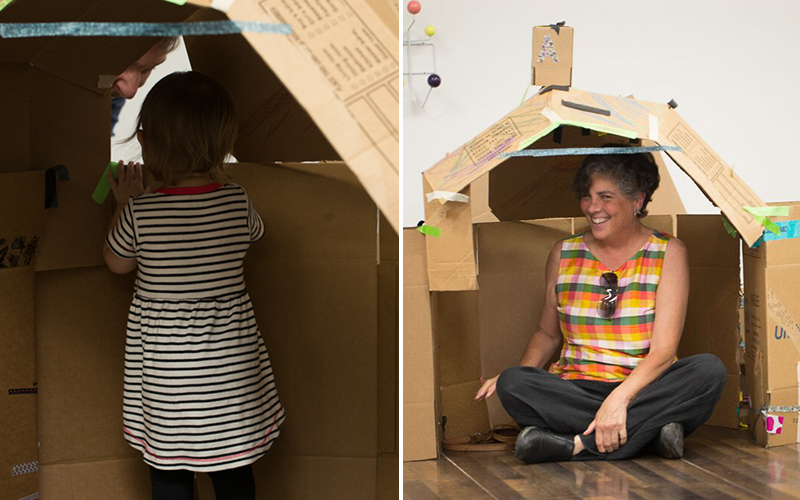You might have seen The Rockwell and other museums around the U.S. launching “Museum from Home” resources in the past couple of weeks, designed to help supplement your distance learning school activities and keep your students engaged and entertained. We know you’re probably balancing your home turning into the office, school, gym and playground and have a lot of other things to think about besides teaching your child art! However, art-making and creative play are proven mood boosters for children and adults alike. This blog series offers some tips and tricks for incorporating art into your new routines.
One thing I grapple with when programming hands-on spaces such as the KIDS ROCKWELL Art Lab and Creative Corner is the physical waste generated by “make-and-take” projects. Plus, with a niece and two nephews whom I consider to be baby geniuses, I have a glimpse into the challenges parents face when art projects multiply exponentially – and each and every one is precious! Generally, I would advise that we not worry too much about paper waste if painting projects keep the kids happy, engaged, using their imaginations and learning. But, it is useful to advocate for the notion that “being creative” does not necessarily equal creating. How can you strike a healthy balance between the two?

Museum educators focus on “informal learning theory” or “experiential learning.” We work to create environments in which learners of all ages can explore at their own pace. We encourage using one’s own background knowledge to create new connections. This might be done through an interactive activity in an exhibit or through an open-ended question posed next to a work of art. Art museums often also offer art-making classes, but art making is just one aspect of what we strive to teach. Experiential learning helps people access their imagination without any pressure to produce or create a finished project.
Much like this museum model, kids should both engage in art-making as well as experiential learning, or imaginative play. Learning through creative play is an integral part of early childhood development that teaches self-regulation and executive functioning. It’s true that learning through play is critical in the earliest years of life, but imaginative play also continues to benefit us as we age. We think less about it as our children learn to entertain themselves. While video games and screen-based learning have their place, experiential/imaginative learning happens when you put those down. How can you support this type of play for upper elementary or middle school ages? Depending on where you’re at in your household, you can be as involved in play as setting up scavenger hunts, or you can pull a few objects at random out and task your kids with making up a game.

Of course, you might have kids that aren’t in the right season of their life for costumes, puppet theaters or mud kitchens. There’s an unlikely hero here to help: social media! Creating supervised video skits is a great way for preteens and teens to engage in creative play that feels trendy and keeps them connected to their social world. Encourage them to create skits that the whole family can participate in. Allow them to take some charge over the activity to foster leadership and decision-making skills. Who knew, right?
Some of the most creative adults I know would never admit to “being creative.” We often mistake “self-expression” for “artistic talent.” We’ve mentioned in earlier blog posts the intimidating label of artist or creative. No one has a monopoly on self-expression, and the longer it’s reinforced as a positive thing as we age, the better. Reinforce for your kids, no matter their ages, that what they’re doing is creative and that you’re impressed when they use their imagination. As we touched on in STEM to STEAM, imagination is critical for advancement in STEM fields as well as in art. There’s also been conversation lately around the loss of hobbies as cash-strapped millennials turn everything into a “side hustle.” This lack of imaginative or expression outlets contributes to burnout. Encouraging creativity during various stages of child development lays the groundwork for innovative – and well-rounded – adults.

Living alongside imaginative play at home can be noisy, messy and even chaotic. Of course, enforcing that everyone clean up after themselves only extends the exercise in independent thinking! As you foster this in your children, you might ask yourself what you can do to reclaim some imaginative play in your busy day. If you’re interested in this topic, check out The Strong Museum of Play in Rochester. NY. They’re updating their blog with play tips as well as crowd-sourcing play stories during this time. You can add yours here.
Still have questions?
The author of this series has taught art classes for 5 to 13-year-olds in one room at one time, does not hold a fine art degree and boldly leads parents with infants through museums. If you have specific questions about how to tailor a lesson to your multiple ages at home or how to get the most out of your DIY art curriculum, ask me anything!
Kate Swanson – SWANSONK@ROCKWELLMUSEUM.ORG



